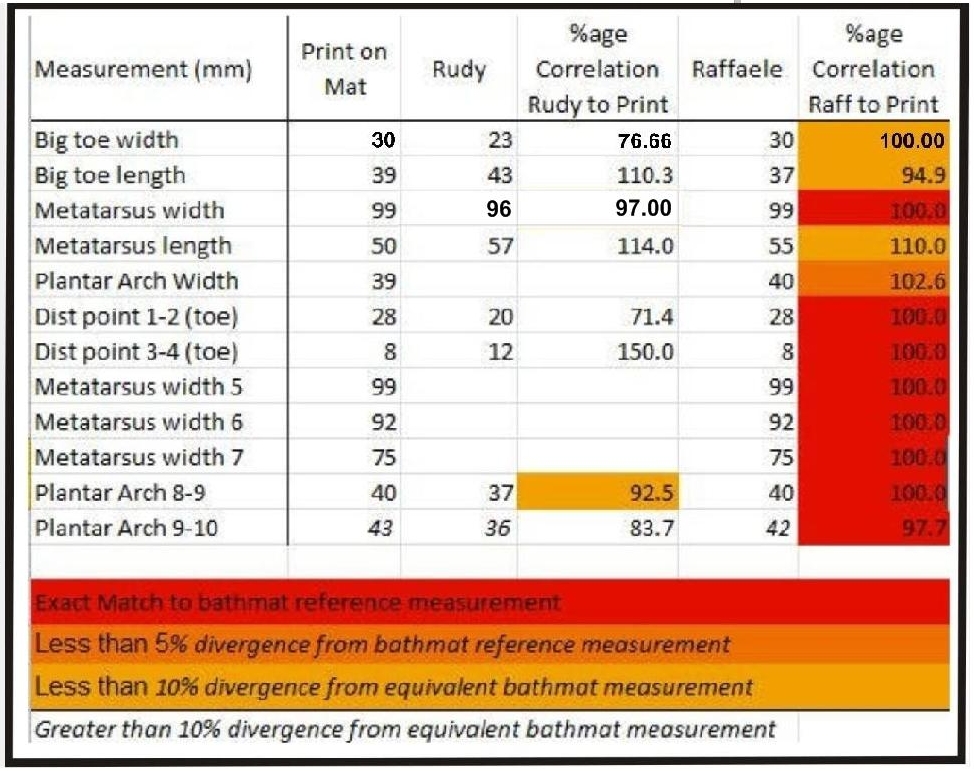
Category: Evidence & Witnesses
Sunday, May 12, 2013
With Diffamazione Complaint Against False Claims In Oggi Knox’s Legal Prospects Continue To Slide
Posted by Our Main Posters
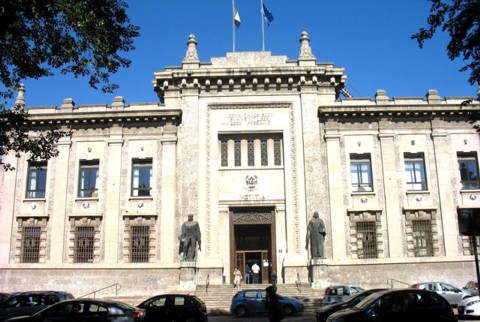
[Above: the Palace of Justice in Bergamo where Knox and Sollecito might spend some time]
Knox’s public relations campaign is starting to look very, very odd.
As many of our recent posts have explained, no really good lawyer in Italy would ever allow their clients to put out an inflammatory book while their legal process is still going on. It hasn’t happened in any other Italian cases in years.
And now in this case it has happened twice.
Sollecito’s book reeked of blood money, arrogance and contempt, it twisted and discounted much of the evidence, made claims which both Sollecito and others had previously contradicted, made accusations of criminal behavior against officers of the court, and separated himself from Knox.
Now guess what?
Despite the fact that Sollecito’s book was promptly dispatched to the Florence and Verona chief prosecutors with diffamazione and vilipendio complaints, Knox’s book too reeked of blood money, arrogance and contempt, it too twisted and discounted much of the evidence, it too made claims which both Knox and others had previously contradicted, it too made accusations of criminal behavior against officers of the court, and it separated her from her co-perp.
In each case there was a shadow writer, respectively Andrew Gumbel and Linda Kulman, who seem to have tired early on of the clients, as all their hired help tends to do, and simply copied the FOA playbook into the books with no sources at all checked beyond that narrow group.
To cool-headed and informed people who really know the case, Gumbel’s sources were rather a joke. PR shills Nina Burleigh and Candace Dempsey and Steve Moore? Really? And Linda Kulman seems to have fallen into the same trap.
This becomes very obvious when you watch the two “authors” at their interviews. They are both hampered and tongue-tied because for the life of them neither can remember what their shadow writers put in the books. Several interviewers have actually caught them out.
As we knew the Bergamo lawsuit against Oggi and Knox was headed down the pike, we set out what we consider to be the state of play last Friday. It still stands up, but might be embellished just a bit.
First, here is Andrea Vogt’s helpful description of what’s in the Bergamo complaint..
The 8-page complaint is addressed to the Prosecutor’s Office in Bergamo (near Milan), where the headquarters of the magazine are located. It cites as slanderous the suggestion that Knox was illegally interrogated and maintains that there is no trial or investigation documentation supporting a number of “affirmations that were never made.” Mignini insists Knox was initially heard by him as a witness with key information relevant to the murder of Meredith Kercher, not as a suspect herself.
“Knox never asked for an attorney. She wanted to talk,” Mignini wrote, adding that he did not contest her statements or question her at that time, because she was making a spontaneous declaration regarding Patrick Lumumba’s alleged involvement. [In other words, not about herself.]
The complaint also questions allegations of prison mistreatment and indicates specific persons and neutral institutions as having knowledge on the matter, including the Capanne prison chaplain, U.S. embassy officials, center-right politician Rocco Girlanda and secretary general of the Italy-USA Foundation Corrado Daclon, all of whom visited Knox regularly in prison.
Also contested are phrases reported by Oggi and attributed to Knox’s memoir claiming he had a bizarre past that included a conviction on abuse of office charges that was pending appeal, when in fact he was fully and definitively acquitted of those charges in 2011 by a Florence court.
Italy’s high court (Cassation) recently agreed with his office’s request to re-open the Monster of Florence/Narducci case, the complaint notes. That decision has lent new credence to his long-running investigation of the suspicious 1985 death of a Perugian doctor who some investigators believe was involved (Italy’s Cassation Court in March also ordered Mario Spezi, co-author of the Monster of Florence bestseller, to stand trial for allegedly attempting to pin the blame on another man).
While the targets of the suit are stated to be Oggi and Amanda Knox and her publishers, the REAL target appears set to be the FOA playbook as set out in Amanda Knox’s book. And for that matter in Raffaele Sollecito’s book.
The first complainant (there are expected to be others) Giuliano Mignini has advanced a request for a formidable slate of witnesses, which could come to include even the lawyers for Sollecito and Knox.
Won’t that be fun. As they are interrogated on the stand, each witness is going to have to take a position on what crazy stuff the FOA have pushed into the books.
Did the prosecutor offer Sollecito an illegal deal or not? Did Knox get interrogated about Patrick by the prosecutor while denying her a lawyer or not? Did Knox complain to her lawyers about conditions in prison and if so why do those lawyers and so many others say she did not?
And maybe fifty more sudden-death choices like the above. Gee thanks Oggi and Amanda Knox. This could set some facts straight, in front of the whole world.
Demonizations By Knox: OGGI Charged For Article Conveying False Claims To Italy #2
Posted by Our Main Posters
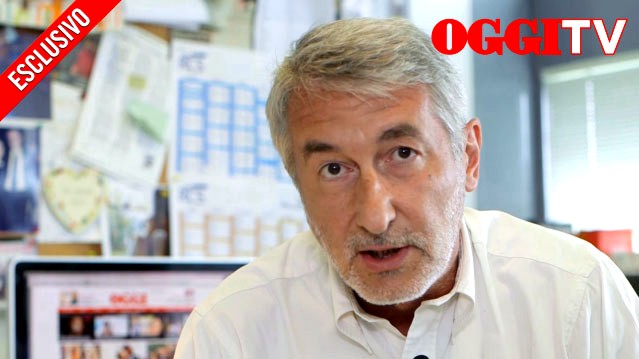
[Umberto Brindani, editor of Oggi, a Mario Spezi ally, being sued for publishing Knox’s claims in Italy]
The decision of Amanda Knox and her lawyers and publishers to flaunt her dishonest claims in Italy seems seriously ill advised.
Pouring gasoline on the fames, it has opened up a fast-track way for those many who she nastily attacks to put the real truths in front of the world. Nobody who foolishly parrots her will be immune from being required to testify by the courts, her own lawyers included.
Here are our own short rebuttals of the Knox claims Oggi specifically flaunts to Italy in its unresearched review.
- Knox was NOT interrogated for days and nights. She was put under no pressure in her brief witness interviews except possibly by Sollecito who had just called their latest alibi “a pack of lies”.
- Knox WAS officially investigated in depth, after she surprisingly “confessed” and placed herself and Patrick at the scene. Prior to that she’d been interviewed less than various others, who each had one consistent alibi.
- Knox herself pushed to make all three statements without a lawyer on the night of 5-6 November 2007 in which she claimed she went out from Sollecito’s house, met Patrick, and witnessed him killing Meredith.
- Far from Knox being denied a lawyer, discussions were stopped before the first statement and not resumed, in the later hearing she was formally warned she needed one; she signed a confirmation of this in front of witnesses.
- Prosecutor Mignini who Knox accuses of telling her a lawyer would hurt her prospects when she claims she asked for one was not even in the police station at that interview; he was at home.
- She was not prohibited from going to the bathroom. At trial, she testified she was treated well and was frequently offered refreshments. Her lawyers confirmed this was so.
- She was not given smacks by anyone. Over a dozen witnesses testified that she was treated well, broke into a conniption spontaneously, and thereafter was hard to stop talking.
- There is no evidence whatsoever that Knox was subject to “something similar to torture” and as mentioned above only Sollecito applied any pressure, not any of the police.
- There is nothing “suicidal” about returning to Italy to defend herself at the new appeal. Sollecito did. She risks an international arrest warrant and extradition if she doesn’t.
- There is no proof except for her own claims of sexual molestations in prison; she is a known serial liar; and she stands out for an extreme willingness to talk and write about sex.
- Many people have testified she was treated well in prison: her own lawyers, a member of parliament, and visitors from the US Embassy were among them; she herself wrote that it was okay.
- She may have based her account on her diaries and “prodigious memory” but the obviously false accusation against the prosecutor suggests that much of the book was made up.
- The investigators had a great deal of evidence against Knox in hand, not nothing, and they were not ever faulted for any action; they helped to put on a formidable case at trial in 2009.
- “Police and Italian justice work with such incompetence, ferocity, and disdain for the truth” is contradicted by a very complete record prior to trial which was praised by the Supreme Court.
- Mr Mignini has NO bizarre past at all. He is widely known to be careful and fair. He would not have been just promoted to first Deputy Prosecutor General of Umbria otherwise.
- He was put on trial by a rogue prosecutor desperate to protect his own back from Mignini’s investigations; the Supreme Court has killed the trumped up case dead.
- There was nothing “mysterious” about Knox being taken to the crime scene to see if any knives were gone, but her wailing panic when she saw the knives was really “mysterious”.
- Knox never thought she was in prison for her own protection; she had signed an agreement at the 5:00 am interview confirming she did know why she was being held.
- Monica Napoleoni did not “bluff” that Sollecito had just trashed their joint alibi; he actually did so, because his phone records incriminated him; he agreed to that in writing.
- There was no crescendo of “yelling and intimidations that lasts from 11 at night until 5.45”. There were two relatively brief sessions. Knox did most of the talking, named seven possible perps, and drew maps.
- There was zero legal requirement to record the recap/summary interview, no recording has “gone missing” and many officers present testified to a single “truth” about what happened.
Demonizations By Knox: OGGI Charged For Article Conveying False Claims To Italy #1
Posted by Our Main Posters

The popular Italian magazine Oggi was sent a review copy of Knox’s book by somebody in the United States.
Oggi has been a frequent vehicle for the Knox entourage version of events, and it has carried a number of lurid pro-Knox splashes. The magazine has a long history of nasty jabs at prosecution and police who as career civil servants under unusually strong rules have no easy ways of explaining their side.
Like all of Oggi’s articles on the case, this shrill and foolish piece is totally one-sided and absolutely unresearched.
- Oggi is ignorant of the fact that many days of testimony by police officers at trial in 2009 contradict Knox’s book, highly convincing testimony, to which Knox on the stand had only the most feeble and unconvincing of responses.
- Oggi is ignorant of the fact that Judge Massei and even Judge Hellmann disbelieved her, and (in extensive reasoning) the Supreme Court (make sure to read parts 3, 7 and 15 there).
- Oggi is ignorant of the fact that Knox was sentenced to three years in prison for the criminal framing of Patrick, and that sentence was confirmed both by Judge Hellmann and the Supreme Court - in effect, unless new FACTS come to light, the truth is known and the case is closed.
The book is already (see next post) the subject of a lawsuit which was filed Friday in Bergamo, where Oggi has its headquarters. Knox is also expected to be investigated for contempt of court. Her book carries at least one no-contest false accusation of a crime: Knox claims the much respected Prosecutor Mignini illegally interrogated her without a lawyer and attempted to make her definitively accuse Patrick Lumumba. This is repeated below. In fact Mr Mignini was not even there.
This translation below of the Oggi piece is by our main poster Catnip. Passages that can EASILY be shown to be false (Oggi would have known they were false with a mere 3-4 hours of research) are highlighted here.
See our own rebuttals in this next post.
Amanda Knox: The American girl’s sensational story
Chilling. No other adjectives come to mind after having read Waiting to be Heard, finally released in the United States. An extremely detailed and very serious charge against the police and magistrates who conducted the investigation into the murder of Meredith Kercher.
Immediately after the crime, Amanda recounts, and for entire days and nights, they had interrogated the American girl and placed her under pressure to make her confess to a non-existent truth, without officially investigating her, denying her the assistance of a lawyer, telling her lies, even prohibiting her from going to the bathroom and giving her smacks so as to make her sign a confession clearly extorted with something similar to torture.
And now the situation is very simple. There are only two choices: either Amanda is writing lies, and as a consequence the police officers and magistrates are going to have to sue her for defamation; or else she is telling the truth, and so they are going to have to go, not without being sanctioned by the CSM [the magistrates’ governing body] and the top brass of the Police. The third possibility, which is to pretend that nothing has happened, would be shameful for the credibility of our judicial system.
Amanda Knox has written her Waiting to be Heard memoir with the sense of revulsion and of relief of someone who has escaped by a hair’s breadth from a legal disaster, but has got her sums wrong. Cassation has decided that the [appeal] proceedings have to be redone and the hearings should be (re)commencing in October before the Florence Court of Appeal.
In a USA Today interview, Ms Knox has not excluded the possibility of “returning to Italy to face this battle too”, but it would be a suicidal decision: it’s likely that the appeal will result in a conviction, and the Seattle girl will end up in the black hole from which she has already spent 1,427 days.
In this way Waiting to be Heard risks being the “film” on which Amanda’s last words are recorded about the Mystery of Perugia, her definitive version.
We have read a review copy. And we were dumbfounded. Waiting to be Heard is a diary that has the frenetic pace of a thriller, written in a dry prose (behind the scenes is the hand of Linda Kulman, a journalist at the Huffington Post), even “promoted” by Michiko Kakutani, long-time literary critic at the New York Times.
The most interesting part does not concern the Raffaele Sollecito love story (which Amanda reduces it to puppy love: “With the feeling, in hindsight, I knew that he… that we were still immature, more in love with love than with each other”), and whoever goes looking for salacious details about the three Italian boys Amanda had casual sex with, one night stands, will be frustrated (Ms Knox describes those encounters with the nonchalance of an entomologist disappointed with his experiments: “We undressed, we had sex, I got dressed again with a sense of emptiness”).
There are no scoops about the night of the murder and even the many vicissitudes endured during the 34,248 hours spent in Capanne prison - the [claimed] sexual molestations suffered under two guards, the unexpected kiss planted by a bisexual cellmate, the threats made by another two prisoners - remain on the backdrop, like colourful notations.
Because what is striking and upsetting, in the book, is the minute descriptions, based on her own diaries, on the case documents and on a prodigious memory, of how Ms Knox had been incriminated (or “nailed”).
COME IN KAFKA. A Kafkian account in which the extraordinary naivety of Amanda (the word naïve, ingénue, is the one which recurs most often in the 457 pages of the book) mixes with the strepitous wickedness of the investigators decided on “following a cold and irrational trail because they had nothing better in hand”.
Devour the first 14 chapters and ask yourself: is it possible that the Police and Italian justice work with such incompetence, ferocity, and disdain for the truth? You place yourself in her situation and you scare yourself: If it happened to me? You’re in two minds: is it a likely accusation, or a squalid calumny, the version of Amanda?
Because in reading it you discover that in the four days following the discovery of Meredith Kercher’s body (on 2 November 2007), Amanda was interrogated continuously, and without the least of procedural guarantees [=due process].
She changes status from witness to suspect without being aware of it.” No one had told me my rights, no one had told me that I could remain silent”, she writes. When she asked if she had the right to a lawyer, the Public Prosecutor, Giuliano Mignini, had responded like this: “No, no, that will only worsen things: it would mean that you don’t want to help us”. Thus, the Public Prosecutor, Giuliano Mignini.
For a long period of time, Ms Knox, who at the time spoke and understood hardly any Italian at all, mistook him for the Mayor of Perugia, come to the police station to help her.
Then, with the passage of time and of the pages, the assessment changes: Mignini is a prosecutor “with a bizarre past”, investigated for abuse of office (he was convicted at first instance, but Cassation annulled the verdict on the grounds of lack of jurisdiction: the case will be tried again in Florence) and with the hunger to fabricate “strange stories to solve his cases”.
Mignini “is a madman who considers his career more important than my liberty or the truth about the killing of Meredith”. On the phone, the Perugian prosecutor reacts with aplomb: “First I will read the book and then I will consider it. Certainly, if it really calls me “˜mad’ or worse, I think I will file suit”.
BEING IN PRISON IS LIKE CAMPING Amanda goes looking. When the officers mysteriously bring her along to the crime scene inspection of the apartment below the one in which she and Meredith were living in, Ms Knox put on the shoe protectors and the white forensics gloves and called out “ta-dah!” spreading her arms “as if I was at the start of a musical: I wanted to appear helpful”.
When they dragged her in handcuffs into Capanne Prison, she believed what the Police would have told her, and that was they would hide her for a couple of days to protect her (from the true killer, one presumes) and for unspecified bureaucratic reasons. “In my head I was camping: ‘This won’t last more than a week in the mountains’ I told myself” writes Amanda.
They take her money off her, and her credit cards, licence [?] and passport, and she draws strength from repeating to herself that “surely they’re not going to give me a uniform, seeing that I’m a special case and that I’ll be here for only a little while”.
But it’s the account of the notorious interrogation that takes the breath away. Around ten in the evening on her last day of freedom, Ms Knox accompanies Raffaele to the police station (he was called in, also without a lawyer, by the Police) and is thrown into a nightmare which she populates with many faces: there is Officer Rita Ficcara, who gives her two cuffs on the head (“To help you remember” she would say); there’s another officer who advises her: “If you don’t help us, you’ll end up in prison for 30 years”; Mignini arrives and advises her not to call a lawyer; super-policewoman Monica Napoleoni dives in and bluffs: “Sollecito has dropped your alibi: he says that on the night of the murder you had left his apartment and that you had told him to lie to ‘cover you’ “.
And a crescendo of yelling and intimidations that lasts from 11 at night until 5.45 in the morning. Seven hours “produce” two confessions that, exactly because they are made without a defence lawyer, cannot be used in the proceedings, but forever after “stain” the image of the accused Knox: Amanda places herself at the scene of the crime and accuses Patrick Lumumba.
RAFFAELE CONFIRMS THE ACCUSATIONS An account of the horror is confirmed by Sollecito in his memoir, Honor Bound, Raffaele writes of having heard “the police yelling at Amanda and then the cries and sobs of my girl, who was yelling “Help!” in Italian in the other room, and of having being threatened in his turn (“If you try to get up and go, I’ll punch you till you’ll bleed and I’ll kill you. I’ll leave you in a pool of blood”, another officer had whispered to him).
Published lines which have passed right under the radar of the Perugian investigators: “No legal action [against the interrogators] has been notified to us,” Franco Sollecito, Raffaele’s dad, tell us. For having recounted the sourness of her interrogation in court, Amanda was investigated for calunnia: the trial will take place in Florence. This one, too, will be a circumstantial case: it’s the word of two young people against that of the public prosecutor and the police.
The recording of the interrogation would have unveiled which side the truth stands on. But it has gone missing.
See our own rebuttals in this next post.
Below: images of the 4-page Oggi spread. Click for larger versions to read.

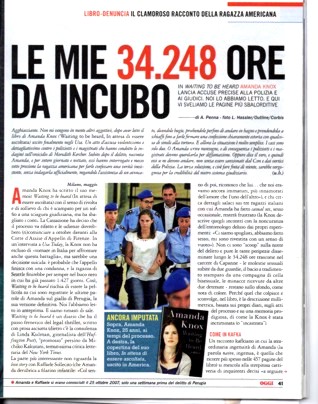
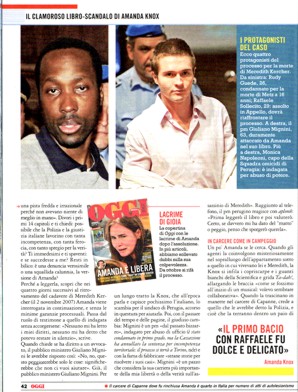
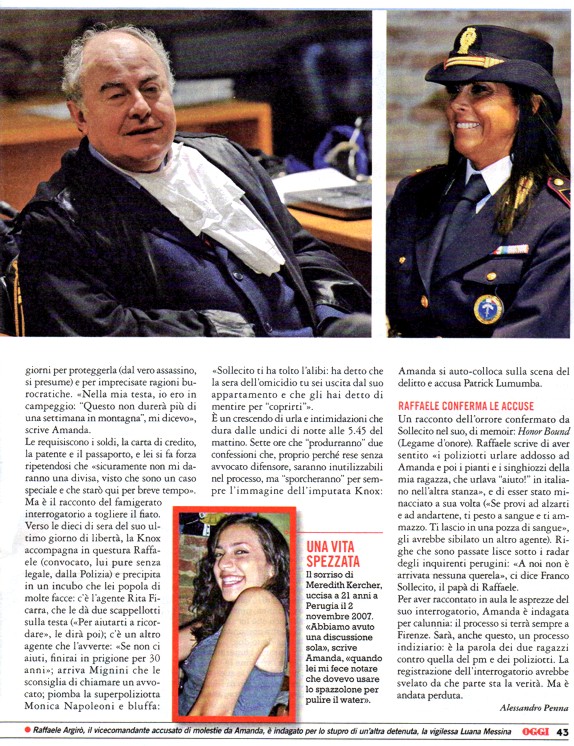
Thursday, May 09, 2013
Demonizations By Knox: She Invents An Illegal Interrogation By Mignini That Never Took Place
Posted by Our Main Posters

[The Perugia Central Police Station where Knox’s imaginary interrogation “took place”]
It is hard to imagine a more extreme form of contempt of court than Knox falsely accusing a respected prosecutor of interrogating her without her lawyer being present, and pressing her to incriminate others.
For this alone, Knox will certainly be investigated and charged. No wonder she is “scared” of returning to Italy. Apart from fears of getting up on the stand, she has lied about and falsely accused way too many people there.
1. What actually happened at Knox’s witness and suspect interviews:
Here is the true account, which has many witnesses, and then her account in the book, which has none.
Before 3:00 AM on 6 November 2007 the respected senior prosecutor Giuliano Mignini had barely set eyes on Amanda Knox.
At that point in time, she had just passed through a purely voluntary witness questioning with the police, who were actually much further ahead in questioning Sollecito and Knox’s flatmates and Meredith’s English friends.
Dr Mignini was at home asleep, but on call if the central police station needed him that night, which is how quite by chance he came face to face with Knox not long before dawn.
Knox’s latest alibi had just been collapsed in another witness interview room. Sollecito had collapsed their joint alibi almost instantly when shown phone records that proved he had just lied. He then declared their current alibi to be a pack of lies.
Told of this, Knox then floundered for a new explanation, turning finally to fingering her employer Patrick Lumumba who the police did not even know to exist until her phone record showed he did.
Police took down that statement, Knox signed it, and this at 3:00 am was the state of play.
Knox was in a waiting room and not under arrest. Mignini was required to warn Knox of her rights as a new suspect, and to warn her to do no further talking to him or anyone else around without a lawyer present.
This was especially so as Knox was inclining to babble on and on and officers were trying to calm her down. As the police had just found (and as her own lawyers later found) she can prove very difficult to stop.
This relatively brief meeting (in which Mignini made quite clear who he was, witnesses confirm) was extended to allow Knox to fine-tune her accusation of Patrick.
She shrugged off the right to have her lawyer there. Prior to this, Knox to Mignini was simply one of a whole lot of people who might be of interest, nothing more.
2. Knox’s invented version of the witness interview which never happened
This interrogation quoted from Knox’s book below is already attracting serious attention in Italy. Why? Because its just not her babbley tone, and because it never even took place.
Amanda Knox, Waiting To Be Heard, HarperCollins, Pages 90-92
[Description is of the end of Knox’s voluntary witness interview with police which Mignini did not attend; the most damaging claims are in bold]
Eventually they told me the pubblico ministero would be coming in.I didn’t know this translated as prosecutor, or that this was the magistrate that Rita Ficarra had been referring to a few days earlier when she said they’d have to wait to see what he said, to see if I could go to Germany.
I thought the “public minister” was the mayor or someone in a similarly high “public” position in the town and that somehow he would help me.
They said, “You need to talk to the pubblico ministero about what you remember.”
I told them, “I don’t feel like this is remembering. I’m really confused right now.” I even told them, “I don’t remember this. I can imagine this happening, and I’m not sure if it’s a memory or if I’m making this up, but this is what’s coming to mind and I don’t know. I just don’t know.”
They said, “Your memories will come back. It’s the truth. Just wait and your memories will come back.”
The pubblico ministero came in.
Before he started questioning me, I said, “Look, I’m really confused, and I don’t know what I’m remembering, and it doesn’t seem right.”
One of the other police officers said, “We’ll work through it.”
Despite the emotional sieve I’d just been squeezed through, it occurred to me that I was a witness and this was official testimony, that maybe I should have a lawyer. “Do I need a lawyer?” I asked.
He said, “No, no, that will only make it worse. It will make it seem like you don’t want to help us.”
It was a much more solemn, official affair than my earlier questioning had been, though the pubblico ministero was asking me the same questions as before: “What happened? What did you see?”
I said, “I didn’t see anything.”
“What do you mean you didn’t see anything? When did you meet him?”
“I don’t know,” I said.
“Where did you meet him?”
“I think by the basketball court.” I had imagined the basketball court in Piazza Grimana, just across the street from the University for Foreigners.
“I have an image of the basketball court in Piazza Grimana near my house.”
“What was he wearing?”
“I don’t know.”
“Was he wearing a jacket?”
“I think so.”
“What color was it?”
“I think it was brown.”
“What did he do?”
“I don’t know.”
“What do you mean you don’t know?”
“I’m confused!”
“Are you scared of him?”
“I guess.”I felt as if I were almost in a trance. The pubblico ministero led me through the scenario, and I meekly agreed to his suggestions.
“This is what happened, right? You met him?”
“I guess so.”
“Where did you meet?”
“I don’t know. I guess at the basketball court.”
“You went to the house?”
“I guess so.”
“Was Meredith in the house?”
“I don’t remember.”
“Did Patrick go in there?”
“I don’t know, I guess so.”
“Where were you?”
“I don’t know. I guess in the kitchen.”
“Did you hear Meredith screaming?”
“I don’t know.”
“How could you not hear Meredith screaming?”
“I don’t know. Maybe I covered my ears. I don’t know, I don’t know if I’m just imagining this. I’m trying to remember, and you’re telling me I need to remember, but I don’t know. This doesn’t feel right.”
He said, “No, remember. Remember what happened.”
“I don’t know.”At that moment, with the pubblico ministero raining questions down on me, I covered my ears so I could drown him out.
He said, “Did you hear her scream?”
I said, “I think so.”My account was written up in Italian and he said, “This is what we wrote down. Sign it.”
To repeat, Mignini was not even present at the midnight interrogation of Knox by the police, and he certainly never edged her into fingering Lumumba as is being claimed here. Knox herself did that all by herself in the presence of the police.
And she did it again and again. Emphatically.
[Dalla Vedova and Ghirga: did they illegally allow Knox to commit serious felonies in the book?]
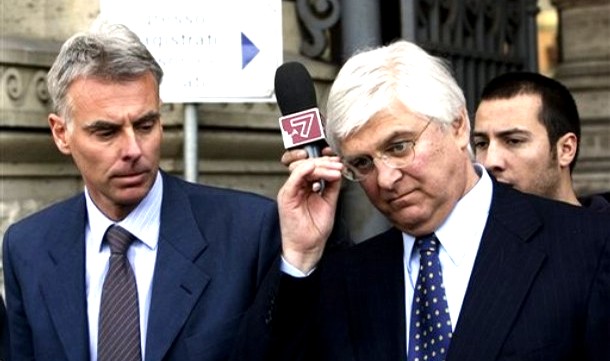
Wednesday, May 01, 2013
A Welcome To New Arrivals #1: An Experienced Trial Lawyer Recommends How To Zero In On the Truth DRAFT
Posted by Some Alibi
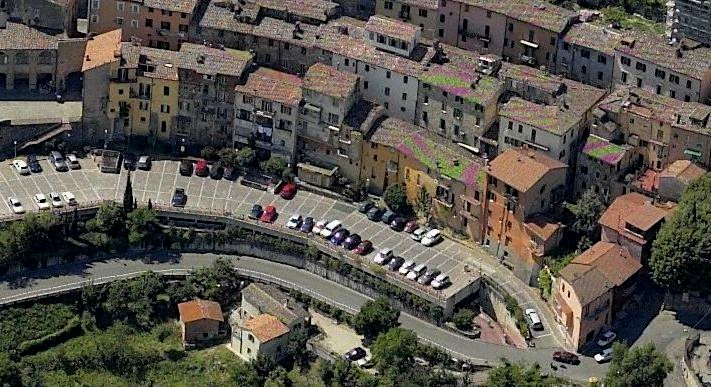
[Merediths window is seen on the top floor of the house in the lower foreground]
Welcome To Common Sense
This briefing was first posted with slightly different opening paras at the start of the annulled Hellmann appeal. New arrivals often tell us this helped them the most.
If you’ve come to this website because of the Amanda Knox book and interview, then welcome. Like all of us who come to this case, you have one key question: did they do it? The Knox book and interview seriously cherrypick the case, and perhaps haven’t helped you at all.
On the Internet, you will find people who are passionate in their defence of Amanda Knox and Raffaele Sollecito; and you will find people who are passionate in their support of an exceptionally talented girl who died, of a fine justice system previously untainted by PR, and of the prosecution’s very strong case.
Please click here for more
Friday, April 19, 2013
Twenty Forensic Reasons Why Guede Could NOT Have Attacked Meredith Alone
Posted by Cardiol MD
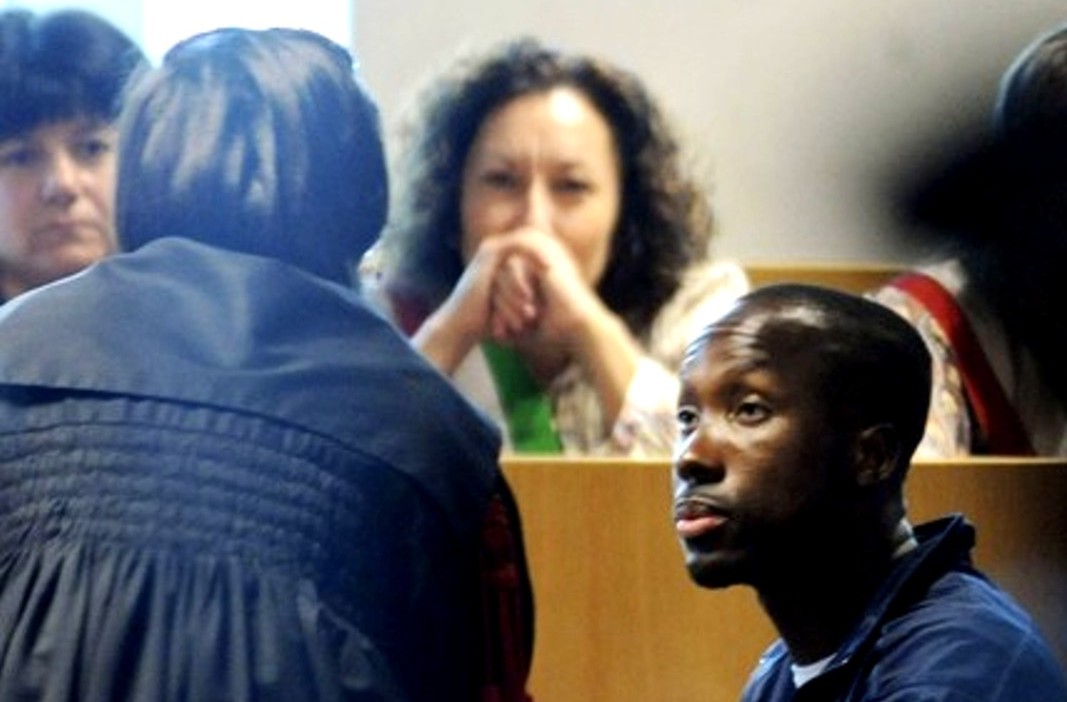
[Bongiorno in 2011 trying to rattle an unshakable Guede claiming Knox and Sollecito did the crime]
1. Guede Persona, An Overview
The convicted murderer Rudy Guede to this day claims that Meredith let him into the house, so we cut him no slack for that.
But at the same time he was no drifter or serial knife carrier, he had no police record in 2007 (unlike Knox and Sollecito), and no drug dealing or breaking-and-entering has ever been either charged or proved.
In October 2008 Judge Micheli mistrusted and sharply rebuked a witness who claimed it just might have been Guede who broke into his house.
Guede seriously discounted his role on the night of Meredith’s death, but some physical evidence (not a lot) proved he had played a part in the attack. Thereafter his shoeprints lead straight to the front door.
2. Moving Target In Court
Neither Judge Micheli nor Judge Massei nor the Supreme Court believed he acted alone or had any part in the very obvious cleanup that had been carried out.
The Knox and Sollecito defenses failed miserably to prove he climbed in Filomena’s window, and despite much innuendo they never really tried to prove he was a lone attacker.
That is why in 2011 we saw two of the most bizarre defence witnesses in recent Italian legal history, the jailbirds Alessi and Aviello, take the stand
Alessi became so nervous making his perjured claim that Guede told him Guede did it with two others that he was physically sick and had to take time off from the stand.
Aviello loudly proclaimed that his brother and another did it (not Guede) and then claimed the Sollecito family via Giulia Bongiorno floated bribes in his prison for false testimony.
Tellingly, although Bongiorno threatened to sue Aviello, she never has. Even more tellingly, Judge Hellmann himself initiated no investigation and simply let this serious felony claim drop dead.
Here is a far-from-exhaustive list of 20 reasons why Rudy Guede could not have acted alone. Also why not one scrap of evidence has ever been found for any two other than Knox and Sollecito themselves.
3. Twenty Lone-Wolf Disproofs
1. Guede’s Final Appeal Report said Meredith sustained 43 wounds
The testimony at the 2009 trial about the 43 wounds was presented in closed court out of humane respect by the jury for the feelings of Meredith’s family.
So even the diligent and trustworthy Italian media mostly missed this, as they were locked outside.
Mention of the 43 wounds was omitted from the 2009 Massei Trial Report and also from the 2011 Hellman Appeal Report.
Its inclusion in the December 2010 in Judge Giordano’s Supreme Court report on Guede’s final appeal reflects the report’s excellent factual completeness.
The PMF translation reads, in relevant part:
The body presented a very large number of bruising and superficial wounds – around 43 counting those caused by her falling – some due to a pointed and cutting weapon, others to strong pressure: on the limbs, the mouth, the nose, the left cheek, and some superficial grazing on the lower neck, a wound on the left hand, several superficial knife wounds or defence wounds on the palm and thumb of the right hand, bruises on the right elbow and forearm, ecchymosis on the lower limbs, on the front and inside of the left thigh, on the middle part of the right leg, and a deep knife wound which completely cut through the upper right thyroid artery fracturing the hyoid bone, a wound which caused a great deal of bleeding.
Including the number of minutes occupied by an initial verbal confrontation, the escalation of that confrontation into taunting and then the physical attack, leading to the infliction of 43 wounds, and to the fatal stabbing, how many minutes would all of this occupied?
The prosecution estimated it took fifteen.
2. Meredith had taken dance classes and played football & karate)
See the Massei Translation, p23.
Every day Meredith called her family, with whom she had a very close relationship. She had taken classes in dance and played sports (football, karate); she was a strong girl, both physically and in terms of temperament (cf. statements by her mother and by her sister Stephanie, hearing of June 6, 2009).
3. Meredith was a strong girl, physically and in temperament
See the statements by her mother and by her sister Stephanie (hearing of June 6, 2009). and description of her karate. (Massei Translation, pp23, 164, 366, and 369).
With regard to the totality of these circumstances, it must be considered that Meredith could only have made an outright refusal to Rudy’s advances and in doing so could also count on her slim [fit] physique, which the photos allow [one] to understand, [and] on her good athletic training (other than dance she had also done sports characterised by a certain physicality such as football, and had even taken a course in karate), sustained by her strong character.
4. Meredith must have been “strongly restrained”
See the Massei Translation, p371; p399, in the Italian original.
Conversely, considering the neck wounds sustained, it must be believed that Meredith remained in the same position, in a standing position, while continuously exposing her neck to the action of the person striking her now on the right and now on the left. Such a situation seems inexplicable if one does not accept the presence of more than one attacker who, holding the girl, strongly restrained her movements and struck her on the right and on the left because of the position of each of the attackers with respect to her, by which it was easier to strike her from that 372 side. One of these attackers was Rudy and the others were those who allowed Rudy to enter the house and who were with him in the house and who, in order to lead the nvestigations astray, then organised the staging of the broken window and the mess in Romanelli’s room: Amanda Knox and Raffaele Sollecito, according to all that has already been shown.
5. Meredith remained virtually motionless throughout the attack
That was in spite of Meredith’s physical and personality characteristics [Massei Translation p369] [Massei Translation p370-371].
A first indication to be taken into account is Meredith’s physical build: the photographs of her body and the data of her approximate height and weight reveal a physique with “normotrophic muscular mass and normally distributed subcutaneous fat” (cf. declarations Lalli p. 3), a slim physique which would have permitted Meredith to move with agility. To this must be added the declarations of the parents and the sister of Meredith. Her mother, Arline Carol Mary Kercher, recalled that Meredith had practised football and karate (p. 7 hearing 6 June 2009), and her sister, Stephanie Arline Lara, stated that Meredith also did boxing, if only the once, and that “physically she was very strong” (p. 20, hearing 6 June 2009). Also her father, John Leslie Kercher, declared that his daughter was quite strong and had taken a course in karate (p. 23 hearing 6 June 2009). It has also been noted that Meredith was not in bed and undressed when the “advances” and the attempts to subject her will commenced. Being still dressed and awake, and since it must be excluded because of what has been said above that the violent action could have taken place with Meredith lying on the bed, it is considered that she, who was sober and fully conscious since no traces indicating either the use of drugs or the abuse of alcohol were found, would have opposed a firm resistance, as she could claim a strong physique, experienced in self-defence by the lessons in karate that she had taken.
6. The defensive wounds were almost non-existent
See the report of Dr Lalli, pp. 33, 34, 35 with the relevant photos. Massei Translation p370.
The signs of this resistance, however, consist in a scream, the scream heard by Nara Capezzali at around around 23:30 and by Maria Ilaria Dramis when, having gone to bed at 22:00 pm, she awoke at a later time which she was not able to quantify; they consist also in some tiny defensive wounds: one on the palm of her [396] right hand of a length of .6cm showing a tiny amount of blood; another on the ulnar surface of the first phalange of the second finger of the left hand, also of length .6cm; another on the fingertip of the first finger with a 370 superficial wound of .3cm, and another tiny wound corresponding to the fourth radius. Compared with these almost nonexistent defensive wounds (cf. report of Dr Lalli, pp. 33, 34, 35 with the relevant photos), there is an injured area which is impressive by the number, distribution and diversity, specifically of the injuries (bruises and wounds) on the face and neck of Meredith.
7. One killer couldn’t inflict 43 wounds with so few defensive wounds.
See the Massei Report quotes above.
8. There must necessarily have been two knives at the scene of the crime
See the Massei Translation p377.
Even this consideration, therefore, leads one to hold that the biological trace attributable to Amanda and found on the knife handle, could have derived from the use of the knife for the purpose of striking, rather than to cut food; it could have derived, therefore, from the harmful action carried out against Meredith and as a consequence, a biological trace attributable to Meredith remained in the tiny striations present on the face of the blade, in spite of the subsequent cleaning, and which does not appear otherwise explainable as to how, in this regard, it was to be found there (Meredith had never been in Raffaele Sollecito’s house and could never have used this knife). Moreover, the knife Raffaele Sollecito carried with him had a definitely shorter blade as has been seen than the length that would have been necessary for causing the deeper resulting wound, with a depth of 8cm, and therefore, there must necessarily have been two knives at the scene of the crime, first one, and then the other, being used against Meredith.
9. A lone killer would need one hand/arm or both to restrain Meredith
So how could he use 2 knives? To use 2 knives a lone killer would have to place 1 knife down, leaving blood-stain[s] wherever it was placed, and then reach for the other knife.
Even wiping the blades on the killer’s clothes, using the one hand, and later scrubbing of the knives would not erase all the blood, as has already been demonstrated.
10. Two killers could divide attack, one holding Meredith, both holding knives
Meanwhile the other killer used one hand/arm to restrain Meredith, and the other hand to use the various knives. Could a lone killer accomplish all that?
11. Meredith’s shoes, pants and underwear had been removed
See the Massei Translation p.370
“It is impossible to imagine in what way a single person could have removed the clothes that Meredith was wearing (shoes, pants and underwear), and using the violence revealed by the vaginal swab, could have caused the resulting bruises and wounds recalled above, as well as removing her sweatshirt, pulling up her shirt, forcing the bra hooks before tearing and cutting the bra.” [Massei Translation p.370]
12. Meredith’s sweatshirt had been pulled up and removed.
See the [Massei Translation p.370
Furthermore, it is impossible to imagine in what way a single person could have removed the clothes that Meredith was wearing (shoes, pants and underwear), and using the violence revealed by the vaginal swab, could have caused the resulting bruises and wounds recalled above, as well as removing her sweatshirt, pulling up her shirt, forcing the bra hooks before tearing and cutting the bra.
13. Meredith’s bra had been forcibly unhooked
See the Massei Translation p.370
14. Meredith’s bra had been torn
See the Massei Translation p.370
15. Meredith’s bra had been cut
See the Massei Translation p.370
16. Violence to Meredith was revealed by the genital swab.
See the Massei Translation p.370
17. In Hellmann appeal RS’s lawyers didnt allege lone killer
They themselves brazenly introduced false testimony to the effect that there were two other killers.
18. Even Hellmann didn’t deny the complicity of AK and RS
Even H/Z seemed to conclude they are probably guilty, but not beyond a reasonable doubt:
“| in order to return a guilty verdict, it is not sufficient that the probability of the prosecution hypothesis to be greater than that of the defence hypothesis, not even when it is considerably greater, but [rather] it is necessary that every explanation other than the prosecution hypothesis not be plausible at all, according to a criterion of reasonability. In all other cases, the acquittal of the defendant is required.” [H/Z p.92]
19. Judge Micheli, in Guede’s trial, found that Guede did not act alone
And that the evidence implicated Amanda Knox and Raffaele Sollecito as accomplices of Rudy Guede in the murder of Meredith Kercher.
20. Massei found that the evidence implicated AK and RS
He concluded they were joint perpetrators with Rudy Guede in the murder of Meredith Kercher.
4. Obvious Conclusions
Is it really reasonable to claim as Sollecito did in his 2012 book that Guede was a lone killer?
Doesn’t all this contradict the lone-killer theory, beyond a reasonable doubt?
Monday, April 08, 2013
Experienced Trial Lawyer: There’s Far More Evidence Than UK/US Courts Need For Guilt
Posted by SomeAlibi
The false claim “there is no evidence”
Some amateur supporters of Knox and Sollecito have committed thousands of hours online to try and blur and obfuscate the facts of the case in front of the general public.
Their goal is simple: to create an overwhelming meme that there is “no evidence” against the accused, and thereby try to create a groundswell of support. Curt Knox and Edda Mellas and Ted Simon have all made this “no evidence” claim many times.
At least some some of the media have eagerly swallowed it.
The amateur PR flunkies make up myriad alternate versions of what created single points of evidence, often xenophobic scare stories designed to trigger emotional reactions, which they hope will be repeated often enough to become accepted as “the truth”.
And where things get really tricky, another time honored tactic is to go on at great length about irrelevant details, essentially to filibuster, in the hope that general observers will lose patience with trying to work it all out.
But time and again we have shown there is actually a great deal of evidence.
Evidence is the raw stuff of criminal cases. Let me speak here as a lawyer. Do you know how many evidence points are required to prove Guilt? One evidence point if it is definitive.
A definitive evidence point
If you’re new to this case or undecided, what is an easy example of ONE definitive evidence item that might stand alone? Might quickly, simply, and overwhelmingly convince you to invest more time into understanding the real evidence, not that distorted by the PR campaign?
In fact we have quite a choice. See the footprint which was second on that list.
Now see the table above. I recommend the use of this table of measurement to avoid the lengthy back and forward of narrative argument which so lends itself to obscuring the truth. I would like to present you with this single table of measurements to give you pause to question whether this line that there is “no evidence” is really true or whether it might be a crafted deception.
I present here a summarized view of critical evidence which suggests with devastating clarity that Raffaele Sollecito was present the night of the murder of Meredith Kercher. No lengthy text, no alternate versions, just measurements.
This FIRMLY places Sollecito in the very room where Meredith was attacked and killed.
In the small bathroom right next to Meredith’s bedroom was a bathmat. On it was found a bloody naked right footprint of someone walking straight towards the shower in the bathroom. The blood is that of Meredith.
The footprint is not Amanda Knox’s - it is too big - but we can compare it to the prints taken of Rudy Guede and Raffaele Sollecito.
In Judge Massei’s report the multiple measurements were detailed in the narrative over many sentences and, in that form, their immediate cumulative impact is less obvious. It is only by tabulating them, that we are forcefully hit by not one but two clear impressions:
The measurements are extremely highly correlated to the right foot of Raffaele Sollecito in twelve separate individual measurements. In themselves they would be enough for a verdict of guilt in all but a few court cases.
But they also show a manifest LACK of correlation to the right foot of Rudy Guede, the only other male in that cottage on the night. Have a look for yourself.
If you were the prosecution, or indeed the jury, and you saw these measurements of Raffaele’s foot versus the print, what would you think? Answer the question for yourself based on the evidence admitted to court.
Then, if you compare further, exactly how plausible do you find it that the measurements of the bloody imprint are Rudy Guede’s instead?
Not only are some of the individual measurements of Rudy’s imprint as much as 30% too small, but the relative proportions of length and breadth measurements are entirely wrong as well, both undershooting and overshooting by a large margin (70% to 150%).
Conclusions that must follow
Presented with those numbers, would you consider those measurements of Rudy Guede’s right foot to show any credible correlation to those of the footprint on the mat?
Supporters of the two have tried frantically to create smoke screen around this - the wrong technique was used they say (ruled not so by the court) / they are the wrong measurements (all 32 of them? that Raffaele’s are matching exactly or within a millimetre but Rudy’s are out by as much as -30% to +50%...?).
The severity of the impact on the defence is such that there was even a distorted photoshopped version circulated by online supporters of Raffaele and Amanda until they were caught out early on in coverage. But it is hopeless, because these are pure measurement taken against a scale that was presented in court and the data sits before you.
Have a look at the measurements and understand this was evidence presented in court. Whose foot do you think was in that bathroom that night? Rudy Guede? Or was it Raffaele Sollecito on twelve counts of measurement?
And if you find for the latter, you must consider very seriously what that tells you both about the idea there is “no evidence” in this case and who was in the cottage that night…
Wednesday, March 27, 2013
Getting Media Up To Speed With Hard Facts Of Complex Case
Posted by Media Watcher
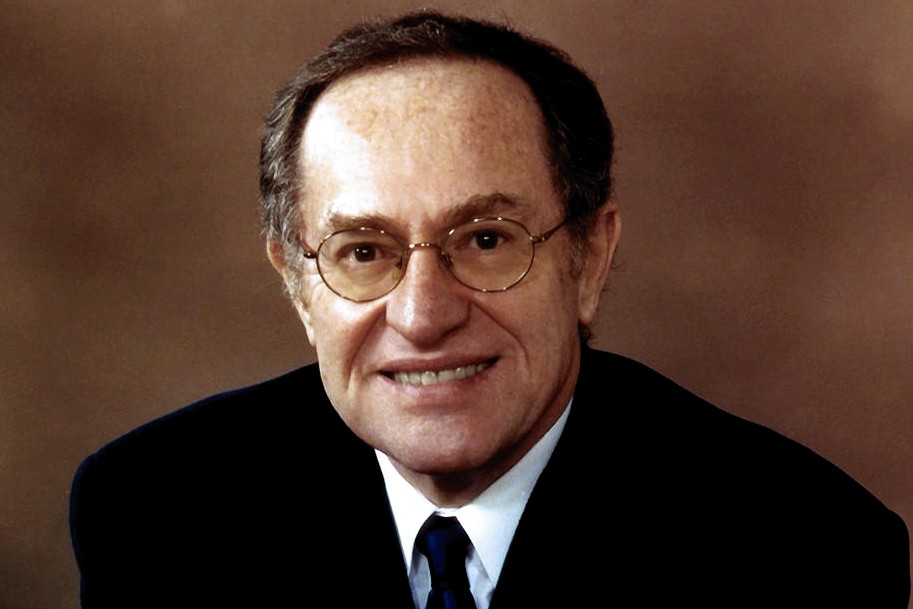
[Above: Harvard “superlawyer” Alan Dershowitz, who conceded yesterday that there IS a strong case]
Getting Back On The Rails
In the United States, with few exceptions, the media has generally accepted the spin from the defense team.
As a consequence, much of the reporting has been shallow and/or wildly inaccurate. These errors have compounded over time, which leads to a situation where the American media was completely unprepared for yesterday’s decision.
As someone who has read through all of the available court documents and much of the media and who has more than 25 years’ experience helping national media to understand complex, technical stories, here’s my take on the issues the media should consider as they continue to write about this case:
Please click here for more
Saturday, March 23, 2013
The Hellmann-Zanetti Appeal Court’s DNA Consultancy Looks Even Worse In Face Of The Latest Science
Posted by Fly By Night
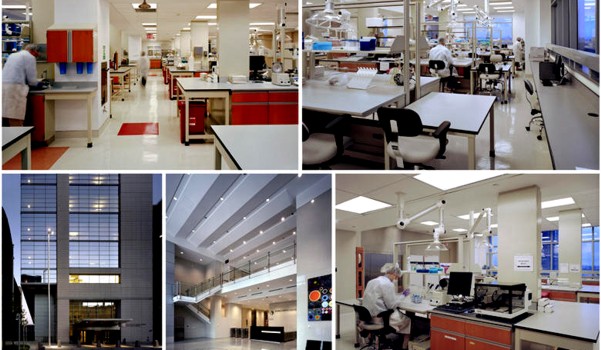
[Above: images of typical modern analysis DNA facilities similar to Dr Stefanoni’s in Rome]
The Galati appeal to Cassation comes down very strongly against the work and conclusions of the appeal court’s DNA consultants Vecchiotti and Conti.
Dr. Galati argues that the consultancy should never have happened at appeal level, that its methods were slipshod and out of date, that its conclusions were mainly innuendo that left the prosecution case untouched, and that the consultants should not have refused to test a remaining sample from the large knife collected at Sollecito’s place.
In July 2011, about the midpoint of the appeal trial, I took strong issue with the C&V science and essentially mirrored in advance what Dr. Galati would argue to Cassation nearly a year later. Many other TJMK posters including our legal posters James Raper and Cardiol took issue with legal and other aspects.
With a Supreme Court ruling on the 2nd level (first appeal level) outcome scheduled for early next week, it’s the perfect time to re-examine the role of DNA in that outcome against the latest science. I want to include some excellent observations from our contributing poster “Thoughtful” as expressed in her recently published book Math on Trial.
I’ll start off with an overview of the science of DNA analysis and describe recent developments in analysis approaches, techniques and capabilities. Incidentally, one of my resources for this information is a chapter in “DNA Electrophoresis Protocols for Forensic Genetics” published shortly after the Hellmann verdict for the first appeal (circa early 2012); a chapter in which Carla Vecchiotti is cited as providing technical assistance.
Given Vecchiotti’s involvement in recent academic publications we can be certain that at the time of the Hellmann verdict Vecchiotti was well aware of the rapidly evolving and improving nature of DNA testing procedures and capabilities. And in contrast to her courtroom allegations that Dr. Stefanoni had not followed “internationally established forensic science standards” in her DNA analysis techniques, Vecchiotti has recently contributed to sources claiming that today’s critical challenge is to develop general guidelines for DNA evaluation and promulgate clear and universal laboratory practices while recognizing that a multitude of labs exist, each with its own specific protocols and personnel.
We will return to the Conti-Vecchiotti report shortly, but first let’s have a quick look at the history and state-of-the-art of DNA analysis.
Brief History of DNA Testing
The literature reveals that the USA has never been at the forefront of forensic DNA analysis. The first court cases to successfully employ DNA “fingerprinting” techniques occurred in England during the mid 1980s. A case involving a double rape/homicide of teenage girls in 1986 turned out to be prophetic in that it involved the first use of DNA to exonerate an innocent suspect and also was the first to apply DNA “databases”, issues which still give rise to disputes nearly 30 years later.
Over time, a variety of procedures were developed to extract DNA from biological samples but all worked on the same basic principle of breaching individual cell walls, removing the protein surrounding the DNA, isolating the DNA, and finishing with the purification and quantification of the DNA.
An important milestone in DNA fingerprinting was the development of the Polymerase Chain Reaction (PCR) in 1985. The PCR quickly became an important analytical method for forensic samples because of its sensitivity, specificity, rapid analysis, and ease of automation. PCR amplification technology permitted the analysis of forensic samples with low quantities (less than 1 ng) of extracted DNA, unlike earlier methods that required at least 50 ng.
While PCR was far more sensitive than earlier procedures, problems with mixed DNA samples and DNA degradation led to the use of genetic markers known as Short Tandem Repeats (STR). STR analyses were fast and reactions could be multiplexed permitting multiple loci to be amplified in a single run.
In 1997 the Federal Bureau of Investigation (FBI) Laboratory in the USA launched an effort to establish a set of 13 core STR loci for use within a national DNA database known as CODIS (Combined DNA Index System). Similar sets of STR markers had already been selected by the European Union and elsewhere but, in general, a DNA profile obtained using 12 or more STR loci was found to yield a composite genotype frequency of less than 1 in a quadrillion. This high degree of accuracy results from the hereditary nature of STR distribution and enables a very powerful method for biological identifications.
STR typing of extracted DNA has traditionally been very sensitive to the quantity of input DNA with ideal levels ranging from 0.5 to 2 ng. Either too little or too much DNA could produce imbalanced amplification results resulting in incomprehensible outcomes. The STR process is further complicated by “stutter” in the interpretation of multiple contributor DNA samples. Stutter is an artifact of the PCR process that produces “false alleles” one repeat shorter than a primary allele.
In recent years DNA analysis techniques have evolved rapidly as equipment manufacturers upgrade STR systems to tolerate even the smallest of samples and samples that have been highly degraded. The improved sensitivity of today’s STR kits along with the development of new strategies for the amplification of low levels of DNA now allows samples which previously could not be analyzed to produce viable results.
Low-level DNA samples often contain mixtures of DNA, which has complicated the detection and interpretation process due to stochastic sampling effects that include peak imbalance, enhanced stutter, allele loss (allele drop-out), and un-attributable alleles (allele drop-in). With this in mind, strict guidelines have been developed including a careful determination of analytical thresholds and the use of replicate analyses in a profile to properly interpret low-level mixed-DNA samples. More importantly, new analytical techniques such as laser micro-dissection and fluorescence in-situ hybridization have been developed enabling the identification, capture, and amplification of DNA from individual cells prior to “electrophoresis”, eliminating the problem of mixed profiles altogether.
In addition to today’s far more precise DNA analysis machines and methods there are also compelling arguments for the use of statistical or probabilistic models within the DNA analysis process to augment traditional “consensus allele” electropherogram evaluation approaches. In short, the efforts of both scientists and statisticians are now creating powerful next generation approaches to DNA analyses as we progress through a second decade of highly successful STR typing methodologies.
Logic and Science on Trial
In my 2011 report I challenged Carla Vecchiotti’s contention that Dr. Stefanoni had not followed “internationally established forensic science standards” in her DNA analysis techniques. Vecchiotti herself has conceded to the challenge through her contributions to publications that clearly describe a need to develop generally accepted guidelines for DNA evaluation and to create clear and universal laboratory practices that can be accepted by the diverse population of analytical labs currently operating under divergent operational protocols, all under the direction of professional and expert personnel.
In her excellent and recently published Math on Trial book, contributing poster “Thoughtful” accurately describes how DNA analysis expert Dr. Patrizia Stefanoni proceeded in her laboratory analysis of a small DNA sample found on the blade of a knife confiscated from Raffaele Sollecito’s apartment. Not having what she felt was a sufficient sample to divide for replication of her analysis Dr. Stefanoni took the chance of running her entire sample in a single run.
As is typical of all DNA analyses, Stefanoni proceeded to amplify the results to a point where an electropherogram would reveal meaningful “peaks” and found that a resultant 13 pairs of peaks corresponded precisely to peaks derived from a known sample of Meredith Kercher’s DNA!
In this case it is pointless to attempt to argue that Stefanoni somehow exceeded the amplification limits of her equipment. As outlined in the DNA discussion above, the typical problems associated with an amplification of low levels of DNA are related to peak imbalances, enhanced stutter, allele drop-outs, or allele drop-ins. In this case there was nothing but a perfect match for Meredith that even Carla Vecchiotti and Stefano Conti could not deny in court.
Stefanoni had clearly identified an identical match for Meredith’s DNA on the blade of Sollecito’s kitchen knife, leaving Vecchiotti and Conti no other option than to argue for “contamination” in court. However, it was convincingly demonstrated by Stefanoni and all evidence handlers that from knife collection through laboratory analysis no reasonable opportunity for contamination with Meredith’s DNA existed.
In the first appeal trial, Judge Hellmann was thus presented with exceptionally compelling evidence that Meredith’s DNA was in fact found on the alleged murder weapon that had been confiscated from Raffaele Sollecito’s apartment. Astonishingly, Hellmann rejected this evidence on an expressed assumption of non-compliance with testing techniques established by international scientific community standards; compliance standards that Vecchioti herself admits do not exist via recent academic and scientific publications as discussed above.
As “Thoughtful” carefully explains in Math on Trial, Hellmann’s faulty reasoning in excluding the knife evidence did not end there. Hellmann provided Vecchiotti and Conti with an opportunity to retest any remaining DNA on the knife if they felt it was warranted. Vecchiotti and Conti declined to perform any retests on the basis that that only a few cells might still exist on the knife, thus invalidating any potential results according to a false assumption that “international testing standards” somehow prohibited such low-level DNA tests even though, as outlined in the DNA discussion above, single-cell DNA analysis had at that time already become an acceptable possibility and Vecchiotti knew it.
Hellmann, however, accepted Vecchiotti and Conti’s reasoning by essentially stating that repeating an “invalid” DNA analysis procedure twice can do nothing towards resolving a DNA identification problem because two wrongs do not make a right. In Math on Trial, “Thoughtful” artfully explains the complete failure of logic of Hellmann’s line of reasoning. Hellmann claims that running an experiment independently two separate times and obtaining the same result each time can do absolutely nothing towards increasing the assurance of reliability for an event.
However, “Thoughtful” describes how successfully repeating Stefanoni’s low-level DNA analysis technique could easily carry a probabilistic result from a “not beyond a reasonable doubt” percentage range to a highly convincing 98.5% or higher probability. “Thoughtful’s” arguments in Math on Trial are completely in line with today’s efforts to embed statistical and probabilistic models within the DNA analysis process for a much higher precision and accuracy standard.
Conclusions
In 2011 I concluded that Vecchiotti and Conti’s expert report findings actually boiled down to two primary debates: (1) Issues surrounding the small sample (Low Copy Number ““ LCN) DNA analysis techniques employed by Dr. Stefanoni, and (2) Issues surrounding the probability of excluding all possible sources of contamination from the evidence.
In 2013, on the eve of the Court of Cassation ruling on the first appeal outcomes of the Meredith Kercher murder trial, it appears to me that all issues related to DNA analysis and contamination have been powerfully addressed by both the prosecution and “best available science” considerations.
The errors in Judge Hellmann’s logic and reasoning that set Amanda Knox and Raffaele Sollecito free have been shown to be plentiful and astounding, as evidenced by the few DNA related examples that have been examined in this report. In light of all of the above and the powerful legal arguments raised by the Galati appeal to Cassation, it seems that there can be no other option than to send this appeal outcome back for a thorough lower court re-evaluation.
Saturday, January 12, 2013
How Much To Place Blame On Guede? IMMENSE Headache For RS & AK Teams
Posted by Cardiol MD

[Photo by Andrea Vogt as in December 2010 Supreme Court decides that Rudy Guede didnt act alone]
Zero To 100% Guede Was Claimed Sole Attacker
On a scale of 0% to 100% how much of the blame for the crime against Meredith has been heaped on Rudy Guede?
Well, it certainly varies. In trial court and first-appeal court it was never ever 100%.
Seemingly very scared of the harm Guede could do to their clients, if they provoked him into telling all, defense lawyers have acted consistently since 2008 and more-so since December 2010 as if they walk on eggshells around him.
In fact among the defendants and their teams only ONCE was Guede ever blamed 100%.
Sollecito’s bizarrely-titled Honor Bound 2012 book, the factually unchecked one, which now is causing him and his defense team so much trouble, was the first instance ever among those accused to try to blame Guede for the crime 100%.
Our next post will look at the categoric claims against Guede by whoever wrote that book. Meanwhile, here and now, let’s start at the beginning.
Commencing from when they were arrested, Amanda Knox pointed decisively at a black man, but of course she pointed at the wrong one: Patrick Lumumba. Make that 0% . Not long after they were arrested, Knox and Sollecito were strongly questioning the role of one another. So 100% against each other, but still a zero against Mr Guede.
In his messages from Germany Guede blamed two hasty intruders though he had no choice but to say he was there. Perhaps 33% at this point. After Guede was captured, Sollecito implied that they were at the crime scene together because he was worried that Guede would implicate him. Make that 50%.
At Guede’s short-form trial In October 2008, Judge Micheli blamed Guede 33% too. In sending Knox and Sollecito to full trial he dismissed the lone wolf theory (never really to be revived in court again) and he tentatively believed the evidence pointed to their being equally guilty.
In fact Judge Micheli tentatively blamed Knox for instigating both the attack on Meredith and the rearrangement of the crime scene. In effect he allocated 50% of the blame to Amanda Knox and 25% each to Guede and Sollecito.
Throughout trial in 2009 the Knox and Sollecito defense teams seemed to take great care not ever to blame Guede 100%, perhaps because (for murky reasons not made public) Rudy Guede had refused to testify against their clients.
Judge Massei assigned Guede 33% of the blame as he concluded that Guede had initiated the attack but that Knox and Sollecito had wielded the knives and that one of them had struck the final blow.
During trial and thereafter, the defense lawyers for the three were often on Italian TV and as our main poster the Italian lawyer Cesare Beccaria exhaustively charted in a four-part series, each “gently” blamed the other two.
We can assume that is either 33% or 50% but never more than that.
On February 24. 2011, in the Supreme Court report, on its rejection of Guede’s final appeal of his sentence for involvement in killing Meredith, blamed Rudy Guede and two others equally. Some 33% of the blame each.
The Supreme Court relied upon three facts: the physical evidence of Guede’s presence at the flat, Guede’s actual admission of his presence, and Guede’s implicit admission of shared-guilt in his documented Skype InstaMessage to Giacomo Benedetti on Nov. 19, 2007 (“I was scared that they would say I was the only guilty person”).
In a nutshell, the situation at the start of the Sollecito and Knox appeal before Judges Hellmann and Zanetti in 2011 was this:
- The Supreme Court had decided that Rudy Guede acting ALONE could not have attacked Meredith with several knives over an estimated 15 minutes, left so little physical evidence upon her, staged the break-in via the absurd route of Filomena’s window while leaving zero DNA in her room, placed Sollecito’s DNA on Meredith’s bra clasp, engineered several traces of Knox’s and Sollecito’s footprints outside the room, and placed the mixed DNA of Meredith and Knox in several different locations outside Meredith’s locked door.
- But there remains zero evidence that perps two and three which the physical evidence strongly pointed to were anyone other than Knox and Sollecito. There’s really not one speck of hard evidence to the contrary. Defenses somewhat desperately tried to engineer some at first appeal from the seemingly perjured testimony of jailbirds Alessi and Aviello and some smoke-blowing over the DNA testing, but in terms of HARD evidence came up empty-handed. Alessi did a meltdown on the stand, while Aviello turned completely cuckoo, and Judges Hellmann and Zanetti had to invent arguments frantically to dig Knox and Sollecito out of that hole.
I have done a series of posts (to be read from the bottom upward) on the Hellmann-Zanetti outcome covering many other aspects of their strange arguments.
Back in late 2010 some of us at TJMK were impressed at the alacrity with which Judge Hellman selected Conti and Vecchiotti.
We were thinking that “he had already thought it all out” [we seem to have got that-much right], and that he was “being prudently responsive to the legal and political pressures bearing down on him, and knows the ruling also calls the defendants’ bluff.”
I had posted that the defenses of Knox and Sollecito seemed to be trying to exclude evidence that they themselves tried to destroy, essentially on the grounds that their destructive attempts failed to destroy all of it, and left behind only some of it. Their argument had boiled down to whether the disputed DNA evidence is more unfairly prejudicial than probative.
It was my opinion that because it was the defendants’ deliberate conduct that nearly succeeded in extinguishing all their DNA, any US and UK courts would admit this highly relevant evidence, and let the participants duke out its fairness, in open court, in front of a jury.
I had thought that was what the Massei Court had already done, and was what the Hellmann/Zanetti court was then doing. The Hellmann/Zanetti court was doing that - but that was not all it was doing, as we now know and regret.
I had believed that the defendants would bitterly regret their petition for such DNA Expert-Opinion Review. We should know in March 2013 if they regret it at all, let alone “˜bitterly’. So far they may not, but Sollecito’s current venture into special-pleading journalism in his book seems likely to accelerate their journey to a bitter and regretted destiny.
We were less impressed with how Judge Zanetti started the appeal hearings.
To his eternal discredit Judge Zenetti uttered words to the effect that “the only thing that is “˜certain’ in Meredith’s case is that Meredith is dead.” Nothing else. In effect, illegally promising a whole new trial at appeal level - very much frowned on by the Supreme Court.
Unless the word “˜thing’ is a mistranslation, that is not the only thing that was already certain in Meredith’s Case; Many Things were then certain in her case.
For example, it is certain that the first-ever documented references to Meredith’s scream just before she was killed had already come both from the mouth of Amanda Knox herself, and from the hand of Amanda Knox, in the case of her contemporaneous personal hand-written notes.
Guede, himself, had certainly already made a documented reference to Meredith’s scream.
It was also certain that Guede had made documented references to his actual presence when Meredith screamed.
Some of these already-certain facts inconveniently undermined Hellmann’s and Zanetti’s already-assumed conclusions, so they then proceeded in-turn to undermine the “˜reliability’ of those facts, e.g. “˜it is not certain that the scream was Meredith’s scream; it could have been someone-else’s scream’; or even Amanda’s scream?
The Massei court had exhaustively presented the evidence from all sources in their conclusion that Knox and Sollecito were the ones who shared Guede’s guilt. But Hellmann/Zanetti then contradicted ALL the previous finders-of-fact with regard to Guede, essentially using five ploys in arguing:
- That Guede was Unreliable: “for example, in the questioning before the Prosecutor, he denies being known by the nickname of Baron, “¦.so as to result in a version completely incompatible with the reality of the facts as perceived and heard…” [Is that ever giving birth to a mouse?], and
- That the Supreme Court had “held Rudy Guede to be an Unreliable person”, and
- That “therefore, among the evidence against the two accused, the testimony given at the hearing of June 27, 2011 by Rudy Guede cannot be included because it is Unreliable, nor can the contents of the letter written by him and sent to his lawyers”, and
- That concerning Guede’s documented Skype InstaMessage to Giacomo Benedetti on Nov. 19, 2007 “”¦ the contents of the chat between Rudy Guede and his friend Giacomo Benedetti on the day of November 19, 2007, also listened to by the Police, can be considered in favour of the two accused”, because “he would not have had any reason to keep quiet about such a circumstance,”
- And that “So, in the course of that chat with his friend….. Rudy Guede does not indicate in any way Amanda Knox and Raffaele Sollecito as the perpetrators…..” and “.....he would not have had any reason to keep quiet about such a circumstance….. he being…. certainly the perpetrator….. of the crimes carried out in via della Pergola, that if Amanda Knox and Raffaele Sollecito had also participated, that he would at that moment have revealed this to his friend.”
So, summarising Hellmann and Zanetti, they have absurdly argued a contradiction:
- Because of Guedes notoriously unreliability, the public evidence in which he did accuse Knox and Sollecito cannot be considered as evidence of their guilt, but
- In spite of Guede’s notorious unreliability, because Guede did not accuse Knox and Sollecito in a private conversation this must be considered as conclusive evidence of their innocence.
We are not the audience to which Dr Galati’s appeal against Hellmann and Zanetti to the Supreme Court is directed. Most of us probably have some difficulty with its legalese, translated into English, so bear with it.
Dr Galati’s appeal against Hellmann and Zanetti refers to Guede’s documented Skype InstaMessage to Giacomo Benedetti on Nov. 19, 2007 as follows:
The Hellmann/Zanetti court, “has”¦ made “¦. completely anomalous use of the Skype call, accepting it for the time of Kercher’s death, but not for other circumstances which are also extremely relevant for judgment purposes, but which have been totally ignored.
In fact, in the call, Guede recounts having heard Meredith complaining about her missing money and of her intention of asking Ms Knox, with whom she had quarrelled, for an explanation (p. 10 of the call [transcript]), of having seen Meredith look in vain for the missing money in her drawer (p. 18), then of having seen Meredith look, still in vain, for her missing money in Amanda’s room (pp. 18-19 of the call [transcript]), and of having heard a girl enter the house, who could have been one of the roommates, thus Amanda (p. 11 of the call [transcript]), while the Ivorian found himself in the bathroom, just before hearing Meredith’s terrible scream which would have caused him [59] to exit the bathroom, about five minutes after the girl’s ingress (p 12 of the call [transcript])”... .
The Court has, in practice, without reason thrown the responsibility onto Guede for throwing the rock and clambering in (see pp 121-122 of the appealed judgment): in the same Skype call, Guede, however, repeatedly denies having seen the broken window in Romanelli’s room during the whole time in which he was in the house at Via della Pergola on that evening (pp 8, 20, 34 of the call [transcript]). Not only that: Rudy Guede also said that he was at Knox’s many times”› (pp 88 of the call [transcript]).
If the Court held the Ivorian citizen to be sincere in the tele-conversation with his friend Benedetti, then why not also believe him when he denies having broken in, or when he recounts Meredith having it out with Amanda, or when he says that he had been at the latter’s place many times”›?
Dr Galati’s appeal to the Supreme Court argues that the Hellmann/Zanetti appeal judgment, apart from being manifestly illogical, is manifestly contradictory with respect to the contents of the case file referred to (Article 606(e) Criminal Procedure Code). Here is what it says about their tortured interpretations of Rudy Guede.
And in the Skype call with Benedetti, intercepted unbeknownst to him, there emerge circumstances that confirm Guede’s court declarations. The Court takes the Skype call with his friend Benedetti into examination, valuing it “šin favour of the two accused”› both for what it does not say and also for what it does say, and this it does building from one, not only unexplained, datum but which would have taken little to deny: since Rudy was outside of Italy, he was in some sense safe”› and thus could well have been able to tell the whole truth (p 40 of the judgment).
Not in the least does the Court depart from the presupposition that in this call Rudy would have been telling the truth and, because in this call he would not have named the current defendants, these have got nothing to do with the homicide. The Court does not explain, though, that even in this call Rudy was tending to downplay his responsibility and, if he had named his co-participants, that would have easily allowed, by means of investigations and subsequent interviews, the bringing out of his causal contribution and of his responsibility.
[91] Of the things said in this Skype call, the Court seems at one moment to want to value the chronological datum from 9:00 PM to 9:30 PM to affirm that this would therefore have been the time of death of Meredith; successively, though the appeal judges, following the principle of plausible hypothesis, in relation to the outgoing calls on the victim’s English handset, have moved it to 10:15 PM, but they have not altered the reliability of the time indicated by Guede.
In truth, during the course of the conversation, Rudy recounts having heard Meredith complain about the missing money and of her intention to ask Knox, with whom she had argued, for an explanation (p 10 of the call); of having seen Meredith look in vain for the missing money in her drawer (see p 18); of having seen her search, again in vain, for the missing money in Amanda’s room (pp 18 and 19 of the call) and of having heard a girl enter the house ““ who must have been one of the flatmates, thus Amanda (p 11 of the call), ““ while he was in the bathroom, a little before hearing Meredith’s terrible scream which would have induced him to exit the bathroom, about five minutes after the ingress of the girl (p 12 of the call).
And also, on the subject of the break-in in Romanelli’s room ““ thrown without explanation onto Guede’s back (see the judgment being appealed from, at pp 121 and 122) ““ can remarks by the Ivorian citizen be found in the transcription of the intercept. Guede repeatedly denies having seen the broken window in Romanelli’s room for the whole time in which he was in the house at Via della Pergola that evening (pp 8, 20, 34 of the call).
If the [Appeal Court] had held as reliable what Rudy narrated in the Skype call relating to the time in which Meredith was killed, it supplies no reason at all, on the other hand, for why it does not believe him as well when he denies [92] having committed the break-in or when he recounts the quarrel of Meredith with Amanda.”
None of this changes my own beliefs that there are even many more things in evidence that are “˜beyond any reasonable doubt’. For example:
- It is beyond any reasonable doubt that Meredith was restrained by hands other than the knife-wielding hand(s); and that Meredith was restrained by the hands of two, or three persons as she was killed.
- It is beyond any reasonable doubt that steps were taken to clean away smears made by Meredith’s blood in the place where she was killed, and tracks of Meredith’s blood transferred by her killers to other places.
- It is beyond any reasonable doubt that steps were also taken to simulate a break-in that never-was.
In the next post, we examine Dr Galati’s appeal further and the strident claims against Guede made in Sollecito’s own book which contradict some of the positions of HIS OWN LAWYERS. Note that Dr Galati has argued in the appeal that it was ILLEGAL for Hellmann and Zanetti not to have taken the Supreme Court’s ruling on three perps fully into account and having innored it or brushed past it.
Verrrry tough situation for defense counsel to be in.


